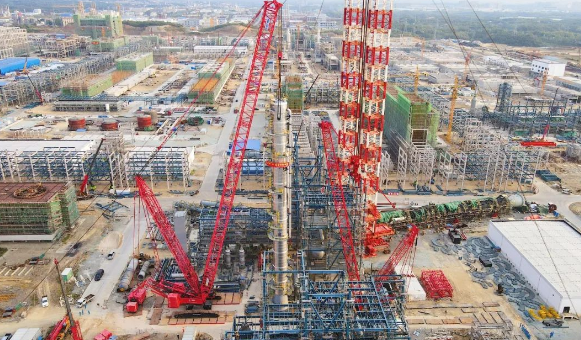The latest progress of Baling Petrochemical Coal Chemical Project with a total investment of 13.95 billion yuan
Latest News: On August 23, 2022, the thermal regeneration tower of the hydrogen ammonia branch purification unit of the Baling Petrochemical caprolactam industrial chain relocation and upgrading and transformation development project was hoisted into place. The thermal regeneration tower is 65 meters high, 4 meters in diameter, and weighs about 300 tons.

There are a total of 173 large pieces of equipment in the project, 51 of which have been hoisted so far.

Baling Petrochemical caprolactam industrial chain relocation project newly built 600,000 tons/year caprolactam. It mainly includes air separation, coal gasification, hydrogen peroxide, cyclohexanone, ammoximation, caprolactam, polyamide and sulfuric acid units.
According to the EIA document published by the Hunan Department of Ecology and Environment, the relocation project of Baling Petrochemical’s caprolactam industry chain will build a new 600,000-ton/year caprolactam. Mainly include air separation, coal gasification, hydrogen peroxide, cyclohexanone, ammoximation, caprolactam, polyamide and sulfuric acid units.
The caprolactam production units are centrally arranged in the middle of the plant and are divided into Line A and Line B. Line A runs parallel to line B.
Process technology and equipment configuration
Air separation The scale of the air separation unit is 90000m3/h oxygen. A line construction.
Coal to hydrogen scale 192000m3/h (CO+H2). The coal-water slurry is used to produce gas, and ammonia synthesis gas and hydrogen are produced as a complete set, and sent to downstream industries. A line construction.
Synthetic ammonia uses nitrogen and hydrogen from the coal-to-hydrogen plant as raw materials, with an annual output of 333,000 tons of liquid ammonia. A line construction.
Hydrogen peroxide adopts the process of “slurry bed palladium catalyst anthraquinone method”. The construction of Line A has an annual output of 120,000 tons of hydrogen peroxide. The scale and process of the hydrogen peroxide plant of line B are the same as those of line A. A total of 240,000 tons / year.
Sulfuric acid production Using the “two-turn and two-suction” process, the annual output of 104.5% sulfuric acid is 660,000 tons. A line construction.
Caprolactam uses benzene, hydrogen, hydrogen peroxide, ammonia, etc. as raw materials to synthesize caprolactam through the steps of esterification cyclohexanone, ammonia catabolization (including rearrangement), ammonium sulfate recovery, and caprolactam purification. The construction of Line A has an annual output of 300,000 tons of caprolactam. The scale and process of caprolactam in line B are basically the same as those in line A. A new oxidation cyclohexanone unit is added, and the cyclohexanone that needs to be purchased in Line A is solved by self-production. A total of 600,000 tons / year.
Polyamide Using caprolactam as raw material, with an annual output of 150,000 tons of polycaprolactam. A line construction.
The total investment of Baling Petrochemical’s caprolactam industrial chain relocation, upgrading and transformation development project reached 13.95 billion yuan, and a 600,000-ton/year caprolactam industrial chain was built, covering the entire industrial chain from coal hydrogen production to polyamide. Ketones, hydrogen peroxide, etc. all adopt new technologies independently developed by Sinopec. The project has been included in the 2020 key project management by the headquarters, and has also been included in the key projects of Hunan Province and the “Five 100” major industrial projects.
The full name of Baling Petrochemical is the Baling Branch of China Petrochemical Corporation. As a subsidiary of Sinopec, a large-scale petrochemical complex integrating oil, chemicals, fibers and fertilizers, Baling Petrochemical is currently the largest SBS, epoxy resin, caprolactam and commercial cyclohexanone manufacturer in China. 4 million tons.
In March 2006, Baling Petrochemical built the first 10,000-ton SEBS industrial plant in China by adopting a complete set of process technology with completely independent intellectual property rights, filling the domestic gap. In September 2012, another thermoplastic rubber (SIS, SEBS) plant with an annual output of 60,000 tons was built, including a SEBS plant with an annual output of 20,000 tons and an SIS plant with an annual output of 40,000 tons. This technology has successively won the first prize of Sinopec Science and Technology Progress Award in 2009, and the second prize of National Science and Technology Progress Award in 2015, and the product was awarded the “National Key New Product”!


